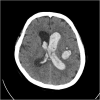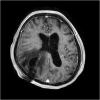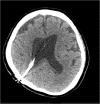Periventricular cyst as a complication of ventriculoperitoneal shunting in the context of intracranial haemorrhage: a case report and review of the literature
- PMID: 38268536
- PMCID: PMC10806387
- DOI: 10.1093/jscr/rjad743
Periventricular cyst as a complication of ventriculoperitoneal shunting in the context of intracranial haemorrhage: a case report and review of the literature
Abstract
Spontaneous intraventricular haemorrhage with hydrocephalus frequently requires neurosurgical intervention, including ventriculoperitoneal shunting. We describe a periventricular cyst following the placement of a ventriculoperitoneal shunt in a 67-year-old female patient. The patient was admitted for rehabilitation after a spontaneous left basal ganglia and diffuse intraventricular haemorrhage with hydrocephalus. Initial management included an extraventricular drain, followed by a ventriculoperitoneal shunt. On Day 5 of rehabilitation, the patient was urgently reviewed for reduced level of consciousness. A cerebrospinal fluid cyst was identified around the shunt catheter, with subacute haemorrhage within the cyst. The patient underwent a successful shunt revision, with rapid improvement in consciousness and resolution of the cyst. This case highlights the importance of pericatheter cyst as a differential diagnosis in patients with altered neurological status following ventriculoperitoneal shunting. Early detection and surgical revision can lead to rapid resolution of symptoms and a favourable prognosis.
Keywords: hydrocephalus; pericatheter cyst; shunt revision; ventriculoperitoneal shunt.
Published by Oxford University Press and JSCR Publishing Ltd. © The Author(s) 2024.
Conflict of interest statement
L.S. and B.Z. report no conflict of interests to declare.
Figures



References
-
- Karydakis P, Nikas I, Panagopoulos D, Filippidou M, Sfakianos G, Themistocleous M. Intraparenchymal Pericatheter cyst after cerebrospinal fluid shunt: a rare complication with challenging diagnosis – case presentation and review of the literature. Asian J Neurosurg 2019;14:581–4. 10.4103/ajns.AJNS_288_18. - DOI - PMC - PubMed
Publication types
LinkOut - more resources
Full Text Sources

